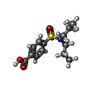+ Open data
Open data
- Basic information
Basic information
| Entry | Database: PDB / ID: 9kl5 | ||||||
|---|---|---|---|---|---|---|---|
| Title | Cryo-EM strucuture of human OAT1 in complex with probenecid | ||||||
 Components Components | Solute carrier family 22 member 6 | ||||||
 Keywords Keywords | MEMBRANE PROTEIN / membrane transporter / antiporter / gout / drug-drug interaction / drug elimination | ||||||
| Function / homology |  Function and homology information Function and homology informationrenal tubular secretion / alpha-ketoglutarate transport / alpha-ketoglutarate transmembrane transporter activity / Organic anion transport by SLC22 transporters / sodium-independent organic anion transport / : / metanephric proximal tubule development / prostaglandin transport / prostaglandin transmembrane transporter activity / organic anion transport ...renal tubular secretion / alpha-ketoglutarate transport / alpha-ketoglutarate transmembrane transporter activity / Organic anion transport by SLC22 transporters / sodium-independent organic anion transport / : / metanephric proximal tubule development / prostaglandin transport / prostaglandin transmembrane transporter activity / organic anion transport / solute:inorganic anion antiporter activity / : / monoatomic anion transport / chloride ion binding / antiporter activity / transmembrane transporter activity / xenobiotic transmembrane transporter activity / basal plasma membrane / caveola / basolateral plasma membrane / protein-containing complex / extracellular exosome / identical protein binding / plasma membrane Similarity search - Function | ||||||
| Biological species |  Homo sapiens (human) Homo sapiens (human) | ||||||
| Method | ELECTRON MICROSCOPY / single particle reconstruction / cryo EM / Resolution: 3.33 Å | ||||||
 Authors Authors | Jeon, H.M. / Eun, J. / Kim, Y. | ||||||
| Funding support |  Korea, Republic Of, 1items Korea, Republic Of, 1items
| ||||||
 Citation Citation |  Journal: Structure / Year: 2025 Journal: Structure / Year: 2025Title: Cryo-EM structures of human OAT1 reveal drug binding and inhibition mechanisms. Authors: Hyung-Min Jeon / Jisung Eun / Kelly H Kim / Youngjin Kim /   Abstract: The organic anion transporter 1 (OAT1) plays a key role in excreting waste from organic drug metabolism and contributes significantly to drug-drug interactions and drug disposition. However, the ...The organic anion transporter 1 (OAT1) plays a key role in excreting waste from organic drug metabolism and contributes significantly to drug-drug interactions and drug disposition. However, the structural basis of specific substrate and inhibitor transport by human OAT1 (hOAT1) has remained elusive. We determined four cryogenic electron microscopy (cryo-EM) structures of hOAT1 in its inward-facing conformation: the apo form, the substrate (olmesartan)-bound form with different anions, and the inhibitor (probenecid)-bound form. Structural and functional analyses revealed that Ser203 has an auxiliary role in chloride coordination, and it is a critical residue modulating olmesartan transport via chloride ion interactions. Structural comparisons indicate that inhibitors not only compete with substrates, but also obstruct substrate exit and entry from the cytoplasmic side, thereby increasing inhibitor retention. The findings can support drug development by providing insights into substrate recognition and the mechanism by which inhibitors arrest the OAT1 transport cycle. | ||||||
| History |
|
- Structure visualization
Structure visualization
| Structure viewer | Molecule:  Molmil Molmil Jmol/JSmol Jmol/JSmol |
|---|
- Downloads & links
Downloads & links
- Download
Download
| PDBx/mmCIF format |  9kl5.cif.gz 9kl5.cif.gz | 104.7 KB | Display |  PDBx/mmCIF format PDBx/mmCIF format |
|---|---|---|---|---|
| PDB format |  pdb9kl5.ent.gz pdb9kl5.ent.gz | 76.8 KB | Display |  PDB format PDB format |
| PDBx/mmJSON format |  9kl5.json.gz 9kl5.json.gz | Tree view |  PDBx/mmJSON format PDBx/mmJSON format | |
| Others |  Other downloads Other downloads |
-Validation report
| Summary document |  9kl5_validation.pdf.gz 9kl5_validation.pdf.gz | 1.4 MB | Display |  wwPDB validaton report wwPDB validaton report |
|---|---|---|---|---|
| Full document |  9kl5_full_validation.pdf.gz 9kl5_full_validation.pdf.gz | 1.4 MB | Display | |
| Data in XML |  9kl5_validation.xml.gz 9kl5_validation.xml.gz | 33.1 KB | Display | |
| Data in CIF |  9kl5_validation.cif.gz 9kl5_validation.cif.gz | 46.6 KB | Display | |
| Arichive directory |  https://data.pdbj.org/pub/pdb/validation_reports/kl/9kl5 https://data.pdbj.org/pub/pdb/validation_reports/kl/9kl5 ftp://data.pdbj.org/pub/pdb/validation_reports/kl/9kl5 ftp://data.pdbj.org/pub/pdb/validation_reports/kl/9kl5 | HTTPS FTP |
-Related structure data
| Related structure data |  62400MC  9kkkC  9klzC  9unxC M: map data used to model this data C: citing same article ( |
|---|---|
| Similar structure data | Similarity search - Function & homology  F&H Search F&H Search |
- Links
Links
- Assembly
Assembly
| Deposited unit | 
|
|---|---|
| 1 |
|
- Components
Components
| #1: Protein | Mass: 61869.027 Da / Num. of mol.: 1 Source method: isolated from a genetically manipulated source Source: (gene. exp.)  Homo sapiens (human) / Gene: SLC22A6, OAT1, PAHT / Plasmid: pEG BacMam / Cell line (production host): HEK293 GnTi- / Organ (production host): kidney / Production host: Homo sapiens (human) / Gene: SLC22A6, OAT1, PAHT / Plasmid: pEG BacMam / Cell line (production host): HEK293 GnTi- / Organ (production host): kidney / Production host:  Homo sapiens (human) / References: UniProt: Q4U2R8 Homo sapiens (human) / References: UniProt: Q4U2R8 |
|---|---|
| #2: Chemical | ChemComp-RTO / |
| #3: Chemical | ChemComp-CL / |
| Has ligand of interest | Y |
| Has protein modification | Y |
-Experimental details
-Experiment
| Experiment | Method: ELECTRON MICROSCOPY |
|---|---|
| EM experiment | Aggregation state: PARTICLE / 3D reconstruction method: single particle reconstruction |
- Sample preparation
Sample preparation
| Component | Name: human OAT1 in complex with probenecid / Type: COMPLEX Details: human OAT1 in complex with probenecid, adopting Inward-facing conformation and embedded in LMNG/CHS micelle. Entity ID: #1 / Source: RECOMBINANT | |||||||||||||||
|---|---|---|---|---|---|---|---|---|---|---|---|---|---|---|---|---|
| Molecular weight | Value: 0.062 MDa / Experimental value: NO | |||||||||||||||
| Source (natural) | Organism:  Homo sapiens (human) / Cellular location: Plasma membrane / Tissue: Kidney Homo sapiens (human) / Cellular location: Plasma membrane / Tissue: Kidney | |||||||||||||||
| Source (recombinant) | Organism:  Homo sapiens (human) / Cell: HEK293 GnTi- / Plasmid: pEG BacMam Homo sapiens (human) / Cell: HEK293 GnTi- / Plasmid: pEG BacMam | |||||||||||||||
| Buffer solution | pH: 7.5 Details: 20 mM HEPES, 200 mM NaCl, 0.0015% LMNG, 0.00015% CHS | |||||||||||||||
| Buffer component |
| |||||||||||||||
| Specimen | Conc.: 15 mg/ml / Embedding applied: NO / Shadowing applied: NO / Staining applied: NO / Vitrification applied: YES Details: this sample is a complex formed by composition of human OAT1, Fab targetting C-terminus of HsOAT1, and the inhibitor probenecid. | |||||||||||||||
| Specimen support | Grid material: GOLD / Grid mesh size: 300 divisions/in. / Grid type: Quantifoil R1.2/1.3 | |||||||||||||||
| Vitrification | Instrument: FEI VITROBOT MARK IV / Cryogen name: ETHANE / Humidity: 100 % / Chamber temperature: 283 K |
- Electron microscopy imaging
Electron microscopy imaging
| Experimental equipment |  Model: Titan Krios / Image courtesy: FEI Company |
|---|---|
| Microscopy | Model: TFS KRIOS |
| Electron gun | Electron source:  FIELD EMISSION GUN / Accelerating voltage: 300 kV / Illumination mode: OTHER FIELD EMISSION GUN / Accelerating voltage: 300 kV / Illumination mode: OTHER |
| Electron lens | Mode: BRIGHT FIELD / Nominal magnification: 96000 X / Nominal defocus max: 2000 nm / Nominal defocus min: 1000 nm / Cs: 2.7 mm |
| Specimen holder | Cryogen: NITROGEN / Specimen holder model: FEI TITAN KRIOS AUTOGRID HOLDER |
| Image recording | Electron dose: 52 e/Å2 / Film or detector model: FEI FALCON IV (4k x 4k) / Num. of grids imaged: 2 / Num. of real images: 22975 |
| Image scans | Width: 4096 / Height: 4096 |
- Processing
Processing
| EM software |
| ||||||||||||||||||||||||||||||||||||
|---|---|---|---|---|---|---|---|---|---|---|---|---|---|---|---|---|---|---|---|---|---|---|---|---|---|---|---|---|---|---|---|---|---|---|---|---|---|
| CTF correction | Type: PHASE FLIPPING AND AMPLITUDE CORRECTION | ||||||||||||||||||||||||||||||||||||
| Particle selection | Num. of particles selected: 8145000 | ||||||||||||||||||||||||||||||||||||
| Symmetry | Point symmetry: C1 (asymmetric) | ||||||||||||||||||||||||||||||||||||
| 3D reconstruction | Resolution: 3.33 Å / Resolution method: FSC 0.143 CUT-OFF / Num. of particles: 97785 / Symmetry type: POINT | ||||||||||||||||||||||||||||||||||||
| Atomic model building | Protocol: RIGID BODY FIT / Space: REAL | ||||||||||||||||||||||||||||||||||||
| Atomic model building | PDB-ID: 8SDZ Pdb chain-ID: A / Accession code: 8SDZ / Source name: PDB / Type: experimental model | ||||||||||||||||||||||||||||||||||||
| Refinement | Highest resolution: 3.33 Å Stereochemistry target values: REAL-SPACE (WEIGHTED MAP SUM AT ATOM CENTERS) | ||||||||||||||||||||||||||||||||||||
| Refine LS restraints |
|
 Movie
Movie Controller
Controller






 PDBj
PDBj







